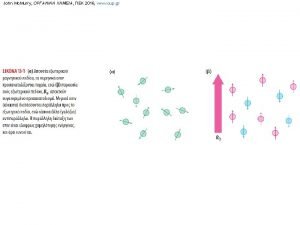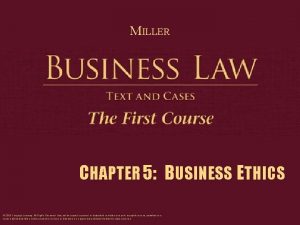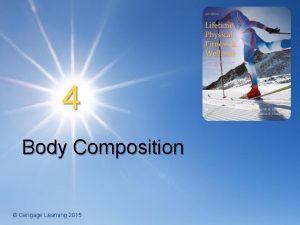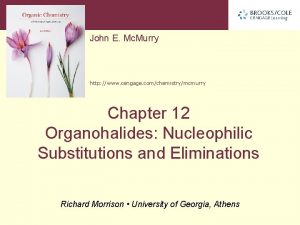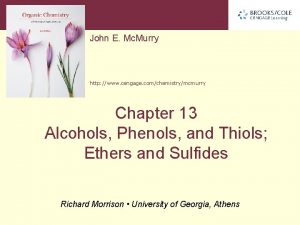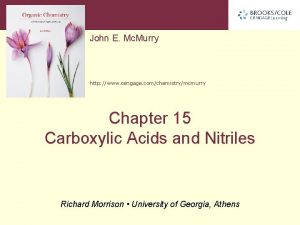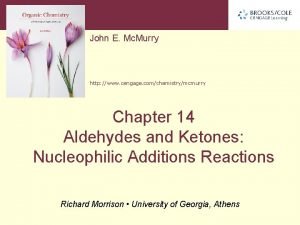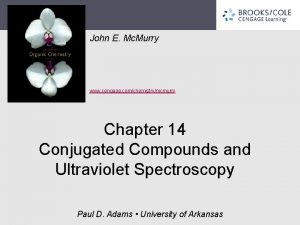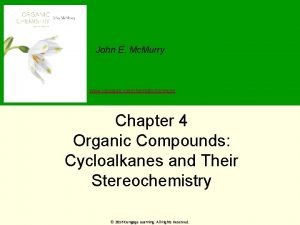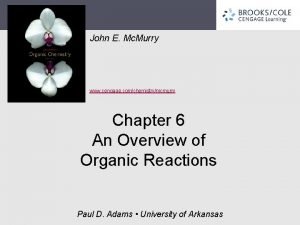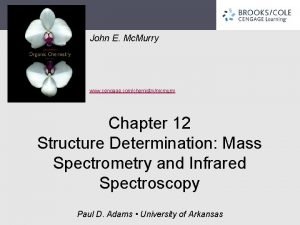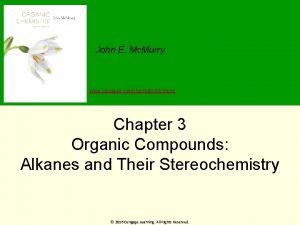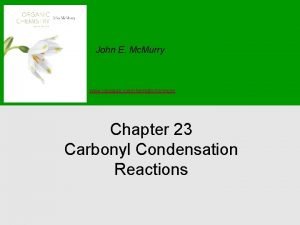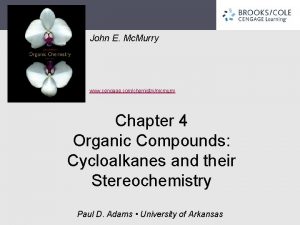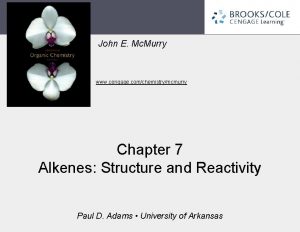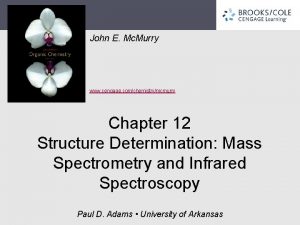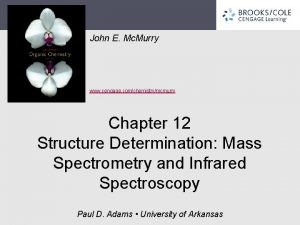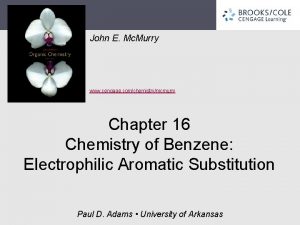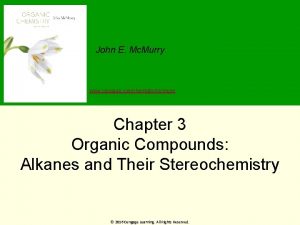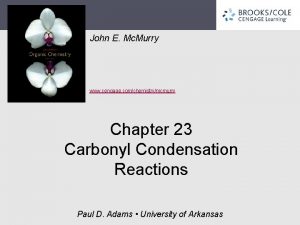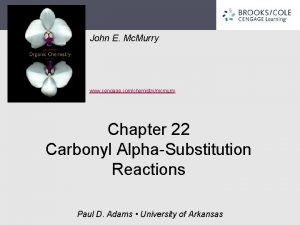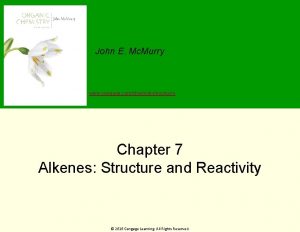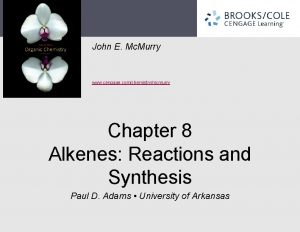John E Mc Murry http www cengage comchemistrymcmurry





















































- Slides: 53

John E. Mc. Murry http: //www. cengage. com/chemistry/mcmurry Chapter 17 Alcohols and Phenols Paul D. Adams • University of Arkansas

Alcohols and Phenols § § § § Alcohols contain an OH group connected to a saturated C (sp 3) They are important solvents and synthesis intermediates Phenols contain an OH group connected to a carbon in a benzene ring Methanol, CH 3 OH, called methyl alcohol, is a common solvent, a fuel additive, produced in large quantities Ethanol, CH 3 CH 2 OH, called ethyl alcohol, is a solvent, fuel, beverage Phenol, C 6 H 5 OH (“phenyl alcohol”) has diverse uses - it gives its name to the general class of compounds OH groups bonded to vinylic sp 2 -hybridized carbons are called enols

Why this Chapter? § To begin to study oxygen-containing functional groups § These groups lie at the heart of biological chemistry

17. 1 Naming Alcohols and Phenols § § General classifications of alcohols based on substitution on C to which OH is attached Methyl (C has 3 H’s), Primary (1°) (C has two H’s, one R), secondary (2°) (C has one H, two R’s), tertiary (3°) (C has no H, 3 R’s)

IUPAC Rules for Naming Alcohols § § § Select the longest carbon chain containing the hydroxyl group, and derive the parent name by replacing the -e ending of the corresponding alkane with -ol Number the chain from the end nearer the hydroxyl group Number substituents according to position on chain, listing the substituents in alphabetical order

Naming Phenols § § Use “phenol” (the French name for benzene) as the parent hydrocarbon name, not benzene Name substituents on aromatic ring by their position from OH

17. 2 Properties of Alcohols and Phenols § § § The structure around O of the alcohol or phenol is similar to that in water, sp 3 hybridized. Alcohols and phenols have much higher boiling points than similar alkanes and alkyl halides. A positively polarized OH hydrogen atom from one molecule is attracted to a lone pair of electrons on a negatively polarized oxygen atom of another molecule. This produces a force that holds the two molecules together These intermolecular attractions are present in solution but not in the gas phase, thus elevating the boiling point of the solution.

Properties of Alcohols and Phenols: Acidity and Basicity § § § Weakly basic and weakly acidic Alcohols are weak Brønsted bases Protonated by strong acids to yield oxonium ions, ROH 2+

Alcohols and Phenols are Weak Brønsted Acids § § Can transfer a proton to water to a very small extent Produces H 3 O+ and an alkoxide ion, RO , or a phenoxide ion, Ar. O

Acidity Measurements § § The acidity constant, Ka, measures the extent to which a Brønsted acid transfers a proton to water [A ] [H 3 O+] Ka = ————— and p. Ka = log Ka [HA] Relative acidities are more conveniently presented on a logarithmic scale, p. Ka, which is directly proportional to the free energy of the equilibrium Differences in p. Ka correspond to differences in free energy Table 17. 1 presents a range of acids and their p. Ka values

p. Ka Values for Typical OH Compounds

Relative Acidities of Alcohols § § Simple alcohols are about as acidic as water Alkyl groups make an alcohol a weaker acid The more easily the alkoxide ion is solvated by water the more its formation is energetically favored Steric effects are important

Inductive Effects Also Important in Determining Acidity of Alcohols § Electron-withdrawing groups make an alcohol a stronger acid by stabilizing the conjugate base (alkoxide)

Generating Alkoxides from Alcohols § § Alcohols are weak acids – requires a strong base to form an alkoxide such as Na. H, sodium amide Na. NH 2, and Grignard reagents (RMg. X) Alkoxides are bases used as reagents in organic chemistry

Phenol Acidity § § § Phenols (p. Ka ~10) are much more acidic than alcohols (p. Ka ~ 16) because of resonance stabilization of the phenoxide ion Phenols react with Na. OH solutions (but alcohols do not), forming salts that are soluble in dilute aqueous solution A phenolic component can be separated from an organic solution by extraction into basic aqueous solution and is isolated after acid is added to the solution

Nitro-Phenols § Phenols with nitro groups at the ortho and para positions are much stronger acids

17. 3 Preparation of Alcohols: A Review § § § Alcohols are derived from many types of compounds The alcohol hydroxyl can be converted to many other functional groups This makes alcohols useful in synthesis

Review: Preparation of Alcohols by Regiospecific Hydration of Alkenes § § Hydroboration/oxidation: syn, anti-Markovnikov hydration Oxymercuration/reduction: Markovnikov hydration

1, 2 -Diols § § Review: Cis-1, 2 -diols from hydroxylation of an alkene with Os. O 4 followed by reduction with Na. HSO 3 Trans-1, 2 -diols from acid-catalyzed hydrolysis of epoxides

17. 4 Alcohols from Carbonyl Compounds: Reduction § § Reduction of a carbonyl compound in general gives an alcohol Note that organic reduction reactions add the equivalent of H 2 to a molecule

Reduction of Aldehydes and Ketones § Aldehydes gives primary alcohols § Ketones gives secondary alcohols

Reduction Reagent: Sodium Borohydride § § § Na. BH 4 is not sensitive to moisture and it does not reduce other common functional groups Lithium aluminum hydride (Li. Al. H 4) is more powerful, less specific, and very reactive with water Both add the equivalent of “H-”

Mechanism of Reduction § The reagent adds the equivalent of hydride to the carbon of C=O and polarizes the group as well

Reduction of Carboxylic Acids and Esters § § Carboxylic acids and esters are reduced to give primary alcohols Li. Al. H 4 is used because Na. BH 4 is not effective

17. 5 Alcohols from Carbonyl Compounds: Grignard Reagents § § Alkyl, aryl, and vinylic halides react with magnesium in ether or tetrahydrofuran to generate Grignard reagents, RMg. X Grignard reagents react with carbonyl compounds to yield alcohols

Reactions of Grignard Reagents with Carbonyl Compounds

Reactions of Esters and Grignard Reagents § § Yields tertiary alcohols in which two of the carbon substituents come from the Grignard reagents do not add to carboxylic acids – they undergo an acid-base reaction, generating the hydrocarbon of the Grignard reagent

Grignard Reagents and Other Functional Groups in the Same Molecule § Cannot be prepared if there are reactive functional groups in the same molecule, including proton donors

Mechanism of the Addition of a Grignard Reagent § § Grignard reagents act as nucleophilic carbon anions (carbanions = : R ) in adding to a carbonyl group The intermediate alkoxide is then protonated to produce the alcohol

17. 6 Reactions of Alcohols § Conversion of alcohols into alkyl halides: - 3˚ alcohols react with HCl or HBr by SN 1 through carbocation intermediate 1˚ and 2˚ alcohols converted into halides by treatment with SOCl 2 or PBr 3 via SN 2 mechanism -

Reactions of 1˚ and 2˚ alcohols

Conversion of Alcohols into Tosylates § § § Reaction with p-toluenesulfonyl chloride (tosyl chloride, p. Tos. Cl) in pyridine yields alkyl tosylates, ROTos Formation of the tosylate does not involve the C–O bond so configuration at a chirality center is maintained Alkyl tosylates react like alkyl halides

Stereochemical Uses of Tosylates § § The SN 2 reaction of an alcohol via an alkyl halide proceeds with two inversions, giving product with same arrangement as starting alcohol The SN 2 reaction of an alcohol via a tosylate, produces inversion at the chirality center

Dehydration of Alcohols to Yield Alkenes § § The general reaction: forming an alkene from an alcohol through loss of O-H and H (hence dehydration) of the neighboring C–H to give bond Specific reagents are needed

Acid- Catalyzed Dehydration § § Tertiary alcohols are readily dehydrated with acid Secondary alcohols require severe conditions (75% H 2 SO 4, 100°C) - sensitive molecules do not survive Primary alcohols require very harsh conditions – impractical Reactivity is the result of the nature of the carbocation intermediate

Dehydration with POCl 3 § § Phosphorus oxychloride in the amine solvent pyridine can lead to dehydration of secondary and tertiary alcohols at low temperatures An E 2 reaction via an intermediate ester of POCl 2 (see Figure 17. 7)

Incorporation of Alcohols into Esters

17. 7 Oxidation of Alcohols § Can be accomplished by inorganic reagents, such as KMn. O 4, Cr. O 3, and Na 2 Cr 2 O 7 or by more selective, expensive reagents

Oxidation of Primary Alcohols § § To aldehyde: pyridinium chlorochromate (PCC, C 5 H 6 NCr. O 3 Cl) in dichloromethane Other reagents produce carboxylic acids

Oxidation of Secondary Alcohols § § Effective with inexpensive reagents such as Na 2 Cr 2 O 7 in acetic acid PCC is used for sensitive alcohols at lower temperatures

Mechanism of Chromic Acid Oxidation § § Alcohol forms a chromate ester followed by elimination with electron transfer to give ketone The mechanism was determined by observing the effects of isotopes on rates

17. 8 Protection of Alcohols § § § Hydroxyl groups can easily transfer their proton to a basic reagent This can prevent desired reactions Converting the hydroxyl to a (removable) functional group without an acidic proton protects the alcohol

Methods to Protect Alcohols § § Reaction with chlorotrimethylsilane in the presence of base yields an unreactive trimethylsilyl (TMS) ether The ether can be cleaved with acid or with fluoride ion to regenerate the alcohol

Protection-Deprotection § An example of TMS-alcohol protection in a synthesis

17. 9 Phenols and Their Uses § § § Industrial process from readily available cumene Forms cumene hydroperoxide with oxygen at high temperature Converted into phenol and acetone by acid

Mechanism of Formation of Phenol

17. 10 Reactions of Phenols § § § The hydroxyl group is a strongly activating, making phenols substrates for electrophilic halogenation, nitration, sulfonation, and Friedel–Crafts reactions Reaction of a phenol with strong oxidizing agents yields a quinone Fremy's salt [(KSO 3)2 NO] works under mild conditions through a radical mechanism

Quinones in Nature § Ubiquinones mediate electron-transfer processes involved in energy production through their redox reactions

17. 11 Spectroscopy of Alcohols and Phenols § § Characteristic O–H stretching absorption at 3300 to 3600 cm 1 in the infrared Sharp absorption near 3600 cm-1 except if H-bonded: then broad absorption 3300 to 3400 cm 1 range Strong C–O stretching absorption near 1050 cm 1 (See Figure 17. 11) Phenol OH absorbs near 3500 cm-1

Nuclear Magnetic Resonance Spectroscopy § § NMR: C bonded to OH absorbs at a lower field, 50 to 80 1 H NMR: electron-withdrawing effect of the nearby oxygen, absorbs at 3. 5 to 4 (See Figure 17 -13) 13 C § § § Usually no spin-spin coupling between O–H proton and neighboring protons on C because of exchange reactions with moisture or acids Spin–spin splitting is observed between protons on the oxygen-bearing carbon and other neighbors Phenol O–H protons absorb at 3 to 8

Mass Spectrometry § § Alcohols undergo alpha cleavage, a C–C bond nearest the hydroxyl group is broken, yielding a neutral radical plus a charged oxygen-containing fragment Radical cation alcohols undergo dehydration to yield an alkene radical anion

Let’s Work a Problem Predict the product from reaction of the following substance with Na. BH 4; then H 3 O+.

Answer There is no product formed with this series of reagents because Na. BH 4 reduces esters very slowly and does not reduce carboxylic acids at all.
 Mc murry
Mc murry Http //mbs.meb.gov.tr/ http //www.alantercihleri.com
Http //mbs.meb.gov.tr/ http //www.alantercihleri.com Http //pelatihan tik.ung.ac.id
Http //pelatihan tik.ung.ac.id Pharyngorrhea
Pharyngorrhea Cengage differential equations
Cengage differential equations Century 21 bank
Century 21 bank Cengage differential equations
Cengage differential equations Cengage chapter 7
Cengage chapter 7 2009 delmar cengage learning
2009 delmar cengage learning Cengage chapter 5
Cengage chapter 5 Cengage learning heart diagram
Cengage learning heart diagram Cengage
Cengage Cengage
Cengage Cengage
Cengage South-western cengage learning
South-western cengage learning Cengage
Cengage Chapter 13 medical math assignment sheet
Chapter 13 medical math assignment sheet Cengage
Cengage Artist
Artist 2009 delmar cengage learning
2009 delmar cengage learning Cengage learning heart diagram
Cengage learning heart diagram Accounting chapter 13 test
Accounting chapter 13 test Chapter 1 introduction to medical terminology answer key
Chapter 1 introduction to medical terminology answer key Cengage learning australia
Cengage learning australia 2009 delmar cengage learning
2009 delmar cengage learning Cengage learning
Cengage learning Cengage learning
Cengage learning Module 2 computer concepts skills training
Module 2 computer concepts skills training Cengage
Cengage Wadsworth cengage learning
Wadsworth cengage learning Compression approach to innovation
Compression approach to innovation Copyright cengage learning. powered by cognero
Copyright cengage learning. powered by cognero Cengage learning
Cengage learning Cengage
Cengage Cengage learning plant cell
Cengage learning plant cell Cengage
Cengage Cengage learning
Cengage learning Motivation, ability, and opportunity consumer behaviour
Motivation, ability, and opportunity consumer behaviour Cengage learning
Cengage learning Consumer diversity in consumer behaviour
Consumer diversity in consumer behaviour Somatic symptom and related disorders
Somatic symptom and related disorders Brooks cole cengage learning
Brooks cole cengage learning Cengage interview process
Cengage interview process Cengage
Cengage Cengage
Cengage Word module 2 creating a research paper
Word module 2 creating a research paper Cengage sequence and series
Cengage sequence and series Cengage intro to business
Cengage intro to business 2014 cengage learning accounting answers
2014 cengage learning accounting answers Cengage
Cengage Quadratic equation cengage
Quadratic equation cengage Cengage layoffs
Cengage layoffs Matrices formula
Matrices formula Cengage.com
Cengage.com
